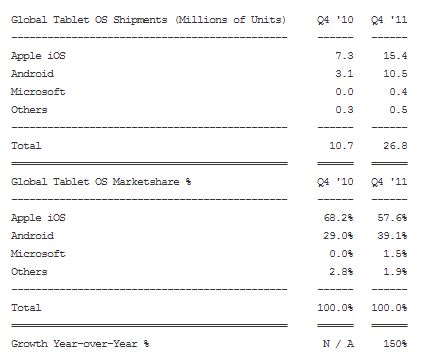Google’s Android OS had a strong Q4. I read this morning that, according to Strategy Analytics, Android’s share of the tablet market now stands at 39%. Sales more than tripled in the quarter. It’s also worth noting that Google released Ice Cream Sandwich in December for the Samsung Galaxy Nexus smartphone on Verizon; although not yet available on tablets, it did help steer a lot of attention Android’s way.
We knew that Apple couldn’t maintain a stranglehold on the tablet market forever. It was first to market, and it reaped the rewards with the iPad (March 2010) and then iPad 2 (March 2011). Design-wise, Apple proved its mettle by changing the game – apps, and gestures are iconic attributes we now associate with Apple’s ground breaking design.
However, we’ve seen this movie before.
In the 1980s it was Microsoft (and IBM) vs. Apple.

Like today, Apple chose an integrated route – hardware, plus software, plus distribution.
And, just as it is today as well, Microsoft went with a horizontal integration model, choosing to license its Windows operating system to other manufacturers.
Apple was (and is) the darling of design. But Microsoft with over 90% desktop OS share was – at least back then – the darling of investors.
Google is the new Microsoft; its decision to open Android has resulted in a myriad of devices. Some may call it fragmented (and there’s justifiable concern, though it’s hard to argue with success), but there’s no denying the result: consumers have lots of choice when it comes to Android tablets, at a variety of price points, from a multitude of retail and online stores.
Take the Amazon Kindle Fire. Apple doesn’t have an answer for the entry $199 tablet. For that matter, if you want a portable offering — 7-inches is a popular size — then you simply must go Android since the iPad is only available with a 9.7-inch display. Fancy a hybrid laptop/tablet? Android, too, has the answer in the form of the Asus Transformer Prime. On a budget? There’s even a $99 door-buster (note: you get what you pay for sometimes…).
This is the same model that Google used to race ahead in the smartphone wars. Then, too, it was second to market. And it’s first release in 2008 (remember the early versions of Android!?) was not exactly Eames worthy. Over time, though, it polished that stone. Soon, it looked pretty damn good. Sure, Android was not as easy-to-use as iOS, but it was more powerful, flexible, and, in many cases, affordable.
A lot is riding on the iPad 3 and iPhone 5. Can CEO Tim Cook continue to serve up the Apple magic? Will we continue to line up around the block for a bit of the old ultra-swag?
But the real question is related not to product releases, but product strategy:
Will Google’s (relatively) open model continue to win market share?



